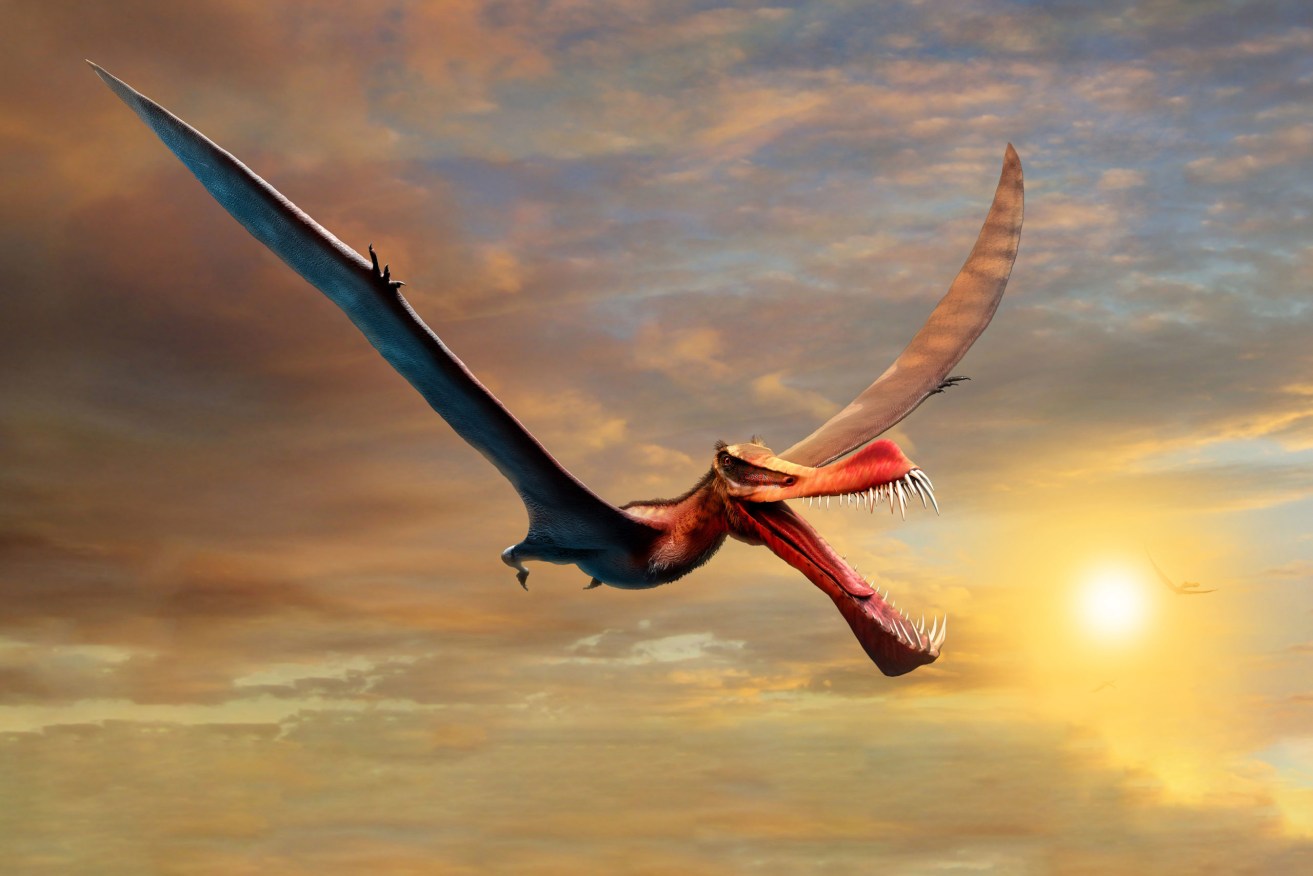When dinosaurs ruled the earth, this Qld ‘dragon’ ruled the sky
The skies of outback Queensland were once ruled by a flying dinosaur with razor sharp teeth and a wingspan as big as a modern-day hang-glider.


An artist's impression of Thapunngaka shawi, Australia's newest dinosaur from Richmond in north-west Queensland.
The chance find of a fossilised bone fragment in remote north-west Queensland 10 years ago has led to the uncovering of Australia’s largest flying reptile.
Thankfully, the pterosaur, with an estimated seven-metre wingspan and spear-like mouth is long dead, no longer a fearsome predator flying above the ancient, vast inland sea once covering much of outback Queensland.
Long buried under metres of soil near Richmond in the state’s north-west, a jaw bone of one of the creatures was unearthed during a roadworks project in 2011 by machinery operator Len Shaw, who also happened to be a keen local fossicker.

The pterosaur’s fossilised jaw fragment, which palaeontologists have used to reconstruct the animal’s likely appearance.
The fragment stayed locked in a drawer of the local museum for years, before University of Queensland PhD candidate Tim Richards took an interest in having it classified as part of his doctoral thesis.
The result is Thapunngaka shawi, belonging to a group of pterosaurs known as anhanguerians, which inhabited every continent during the latter part of the Age of Dinosaurs.
Being perfectly adapted to powered flight, pterosaurs had thin-walled and relatively hollow bones.
Given these adaptations their fossilised remains are rare and often poorly preserved.
“It’s quite amazing fossils of these animals exist at all,” Richards said.
“By world standards, the Australian pterosaur record is poor, but the discovery of Thapunngaka contributes greatly to our understanding of Australian pterosaur diversity.”

An illustration of the pterosaur’s spear-like mouth and skull.
It is only the third species of anhanguerian pterosaur known from Australia, with all three species hailing from western Queensland.
“It’s the closest thing we have to a real-life dragon,” Richards said.
“The new pterosaur, which we named , would have been a fearsome beast, with a spear-like mouth and a wingspan around seven metres.
“It was essentially just a skull with a long neck, bolted on a pair of long wings.
“This thing would have been quite savage.
“It would have cast a great shadow over some quivering little dinosaur that wouldn’t have heard it until it was too late.”
Richards said the skull alone would have been just over one metre long, containing around 40 teeth, perfectly suited to grasping the many fishes known to inhabit Queensland’s no-longer-existent Eromanga Sea.
“It’s tempting to think it may have swooped like a magpie during mating season, making your local magpie swoop look pretty trivial – no amount of zip ties would have saved you,” he said.
“Though, to be clear, it was nothing like a bird, or even a bat. Pterosaurs were a successful and diverse group of reptiles – the very first back-boned animals to take a stab at powered flight.”
Dr Steve Salisbury, co-author on the paper and Richards’ PhD supervisor, said what was particularly striking about this new species of anhanguerian was the massive size of the bony crest on its lower jaw, which it presumably had on the upper jaw as well.
“These crests probably played a role in the flight dynamics of these creatures, and hopefully future research will deliver more definitive answers,” Salisbury said.
The name of the new species honours the First Nations peoples of the Richmond area where the fossil was found, incorporating words from the now-extinct language of the Wanamara Nation.
The genus name, Thapunngaka, incorporates thapun [ta-boon] and ngaka [nga-ga], the Wanamara words for ‘spear’ and ‘mouth’, respectively.
“The species name, shawi, honours the fossil’s discoverer Len Shaw, so the name means ‘Shaw’s spear mouth’,” Salisbury said.
The fossil of Thapunngaka shawi is on display at Kronosaurus Korner in Richmond.
The research has been published in the Journal of Vertebrate Paleontology.








